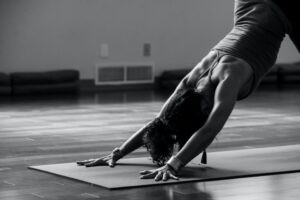In the ever-evolving world of fitness, enthusiasts are continually seeking exercises that provide a balanced fusion of strength and flexibility. Enter Yoga Push-Ups, a dynamic and versatile movement that seamlessly marries the benefits of traditional push-ups with the holistic principles of yoga. In this article, we’ll delve into the world of Yoga Push-Ups, exploring their unique advantages, proper execution, and how they contribute to a well-rounded fitness routine.
The Marriage of Yoga and Push-Ups
Yoga Push-Ups, often referred to as “Chaturanga Dandasana” in the yoga realm, represent a synergy between strength-building and flexibility-enhancing exercises. Traditional push-ups primarily target the upper body, engaging muscles in the chest, shoulders, and triceps. On the other hand, Chaturanga Dandasana, a fundamental yoga pose, emphasizes core strength, arm stability, and flexibility.
The beauty of Yoga Push-Ups lies in their ability to seamlessly blend these two distinct worlds. By incorporating the principles of Chaturanga Dandasana into your push-up routine, you not only intensify the engagement of upper body muscles but also introduce an element of dynamic flexibility, working towards a harmonious balance in your fitness journey.
Advantages of Yoga Push-Ups
- Full Body Engagement: Yoga Push-Ups engage a broader spectrum of muscles compared to traditional push-ups. The integration of yoga principles activates not only the chest, shoulders, and triceps but also the core, lower back, and hip flexors. This results in a more comprehensive full-body workout.
- Improved Core Strength: The inherent nature of Chaturanga Dandasana in Yoga Push-Ups demands significant core engagement. This leads to enhanced core strength, crucial for maintaining stability during various physical activities and promoting good posture.
- Enhanced Flexibility: Unlike standard push-ups, Yoga Push-Ups require controlled lowering of the body, challenging your flexibility as you move through the pose. This dynamic range of motion contributes to improved flexibility in the wrists, shoulders, and spine over time.
- Mind-Body Connection: Yoga Push-Ups emphasize mindfulness and the mind-body connection, a hallmark of yoga practice. Focusing on controlled movements and breath awareness during each repetition not only enhances physical benefits but also promotes mental well-being.
How to Perform Yoga Push-Ups
Executing Yoga Push-Ups requires attention to detail and a gradual progression, especially if you are new to yoga-based movements. Here’s a step-by-step guide:
- Starting Position: Begin in a plank position with your hands directly beneath your shoulders and your body forming a straight line from head to heels. Ensure that your feet are hip-width apart.
- Lowering Phase: As you exhale, bend your elbows and lower your chest towards the ground while keeping your body in a straight line. Your elbows should be close to your ribcage, not splayed out.
- Chaturanga Position: Pause when your elbows are bent at a 90-degree angle, resembling the Chaturanga Dandasana position in yoga. Maintain a straight line from head to heels.
- Upward Dog Transition: Inhale as you transition into an upward-facing dog position. Straighten your arms, lift your chest, and engage your core, while keeping only your palms and the tops of your feet on the mat.
- Downward Dog Transition: Exhale and lift your hips, transitioning into a downward-facing dog position. Lengthen your spine, push your heels towards the ground, and maintain a gentle bend in your knees if needed.
- Repeat: Flow back into plank position and repeat the sequence for the desired number of repetitions.
Incorporating Yoga Push-Ups into Your Routine
Whether you’re a seasoned yogi or a fitness enthusiast looking to diversify your routine, integrating Yoga Push-Ups can be both rewarding and challenging. Here are some tips to make the most of this exercise:
- Start Gradually: If you’re new to Yoga Push-Ups, begin with a lower number of repetitions and focus on maintaining proper form. As your strength and flexibility improve, gradually increase the intensity.
- Listen to Your Body: Pay attention to how your body responds to the movements. If you experience any discomfort or strain, modify the exercise or consult with a fitness professional or healthcare provider.
- Combine with Other Exercises: Incorporate Yoga Push-Ups into a well-rounded workout routine that includes a variety of exercises targeting different muscle groups. This ensures a comprehensive approach to fitness.
- Consistency is Key: Like any exercise, consistency is crucial for seeing results. Make Yoga Push-Ups a regular part of your fitness routine to experience the long-term benefits.
Conclusion
Yoga Push-Ups represent a harmonious marriage between the strength-building prowess of traditional push-ups and the holistic principles of yoga. This dynamic exercise not only targets key muscle groups but also fosters flexibility, core strength, and mindfulness. By incorporating Yoga Push-Ups into your fitness routine, you embark on a journey that transcends the boundaries of conventional exercises, promoting a balanced and holistic approach to health and well-being. So, roll out your mat, embrace the challenge, and discover the transformative power of Yoga Push-Ups.



